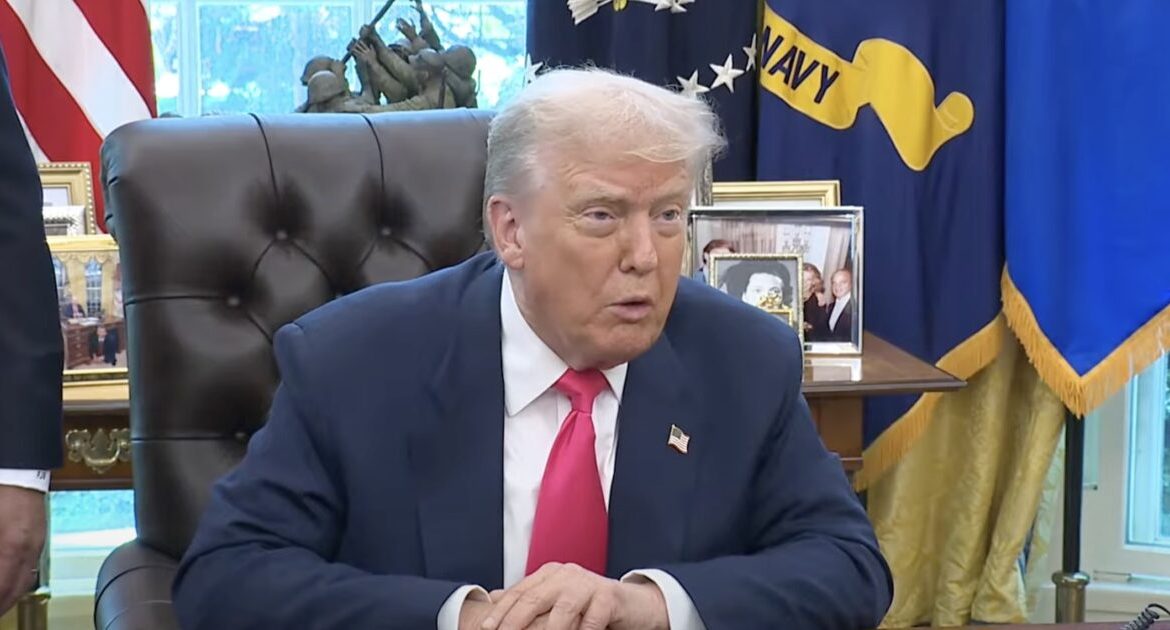
How Congress Can Implement President Trump’s Election Reform Movement and Usher in Hand-marked, Hand-counted Paper Ballots at the Precinct Level


Last week, President Trump declared that he is leading “a movement to get rid of mail-in ballots” and “highly ‘inaccurate,’ very expensive, and seriously controversial voting machines,” claiming that they cost ten times more than “accurate and sophisticated watermark paper.”
President Trump then made a controversial claim: “the States are merely an ‘agent’ for the Federal Government in counting and tabulating the votes” and that “they must do what the Federal Government…tells them…to do.”
Anti-federalists would shockingly align with Voting ‘Rights’ NGOs, who seem to suffer from Trump Derangement Syndrome quite often, and cry out “the state legislatures were prescribed this authority!”
This is of course in reference to Article 1 Section 4, generally called the Elections Clause. And while that is fundamentally correct, it is also only one of two aspects to the Elections Clause and omits that the U.S. Congress still preempts the states’ legislatures.
Art. 1, Sec 4 states:
The Times, Places and Manner of holding Elections for Senators and Representatives, shall be prescribed in each State by the Legislature thereof; but the Congress may at any time by Law make or alter such Regulations, except as to the Places of [choosing] Senators.
Using Congress’s authority under the Elections Clause, there is a simple way that they can restore faith in the elections, streamline their efficiency while bolstering their effectiveness, and ensure the American people that their voice is being heard, at least in federal elections.
The Precedent
In the 1932 case Smiley v. Holm, arguments were heard on whether the state legislature of Minnesota had the authority to redistrict the state without the approval of the governor based on the Elections Clause. In his opinion, Chief Justice Hughes outlined several of the authorities that were entrusted to the state legislatures, but also that the U.S. Congress has the ability to “supplement” or “substitute” its own regulations:
The subject-matter is the ‘times, places and manner of holding elections for senators and representatives.’ It cannot be doubted that these comprehensive words embrace authority to provide a complete code for congressional elections, not only as to times and places, but in relation to notices, registration, supervision of voting, protection of voters, prevention of fraud and corrupt practices, counting of votes, duties of inspectors and canvassers, and making and publication of election returns…
…The phrase ‘such regulations’ plainly refers to regulations of the same general character that the legislature of the State is authorized to prescribe with respect to congressional elections. In exercising this power, the Congress may supplement these state regulations or may substitute its own. It may impose additional penalties for the violation of the state laws or provide independent sanctions. It ‘has a general supervisory power over the whole subject.’
In 1997, the Supreme Court upheld this ‘supervisory power’ in Foster v. Love. Justice Souter was joined by Justices Scalia, Kennedy, and Thomas in the opinion that:
The [Elections] Clause is a default provision; it invests the States with responsibility for the mechanics of congressional elections but only so far as Congress declines to pre-empt state legislative choices. Thus, it is well settled that the Elections Clause grants Congress ‘the power to override state regulations’ by establishing uniform rules for federal elections, binding on the States. ‘The regulations made by Congress are paramount to those made by the State legislature; and if they conflict therewith, the latter so far as the conflict extends, ceases to be operative.’
In a 2021 Washington Law Review by Eliza Sweren-Becker and Michael Waldman titled, “The Meaning, History, and Importance of the Elections Clause,” the authors described the Elections Clause as:
“…a provision of extraordinary, if often latent power. Nowhere else in the original Constitution is Congress given explicit authority to “alter” state laws even absent a conflicting federal statute. It is also one of the few places in the Constitution where states are given an explicit instruction to act – in this case, to ensure the continuation of the federal legislature.”
The Public
Faith in our elections is plummeting. Recent polling shows that public trust in the integrity of our elections has fallen off significantly. In an article from Ryan Shandler, a Georgia Tech Professor of Cybersecurity and International Relations, he writes:
Nearly half of Americans, both Democrats and Republicans, question whether elections are conducted fairly. Some voters accept election results only when their side wins. The problem isn’t just political polarization – it’s a creeping erosion of trust in the machinery of democracy itself.
Commentators blame ideological tribalism, misinformation campaigns and partisan echo chambers for this crisis of trust. But these explanations miss a critical piece of the puzzle: a growing unease with the digital infrastructure that now underpins nearly every aspect of how Americans vote.
In a July 2024 poll from Rasmussen Reports/Heartland Institute, 62% of likely voters are concerned cheating would affect the outcome of the 2024 election, with 37% “very concerned” and only 15% “not at all concerned.”
Another Rasmussen Reports poll from November 18th, 2024, following the 2024 Presidential Election, 65% of voters “believe disputes over election results should be investigated fully, including the use of forensic ballot audits” and that “59% say federal election laws should require the use of paper ballots.”
Matt Blaze, the McDevitt Chair of Computer Science and Law at Georgetown University, just this month called voting machines “unreliable,” “the hardest technical problem in computer science that [he’s] ever encountered bar none” and said that “we don’t know how to build complex software…in ways that actually assure us that they do what we intend them to do.”
Election machines must go. Period.
Here’s some clips of Georgetown Professor Matt Blaze during the most recent DefCon Voting Village 2025:
First, US Elections are the “hardest technical problem in computer science that [he’s] ever encountered bar none.”
That’s a crazy… pic.twitter.com/HgZeRml8EV
— CannCon (@CannConActual) August 24, 2025
“Software is vulnerable” (duh).
But admitting “we don’t know how to build complex software” that “actually assure us they do what we intend them to do”
But sure…let’s use them to ‘elect’ our representatives and control a $26 Trillion economy! pic.twitter.com/E7nH79i5au
— CannCon (@CannConActual) August 24, 2025
The Proposal
The solution is simple. Pass a bill that requires states to separate their state and local elections from federal elections. The bill should include requirements to count the federal ballots under public live-stream at the precinct level.
Volunteers consisting of members from all parties involved from within the community can assist with the counting, under quality live-stream supervision. This would limit the possible number of ballots with 100% turnout to around 2,000 ballots with, at most, three races on them: US House, Senate, and President.
Under federal law, 2 U.S. Code § 7 states that:
The Tuesday next after the 1st Monday in November, in every even numbered year, is established as the day for the election, in each of the States and Territories of the United States, of Representatives and Delegates to the Congress commencing on the 3d day of January next thereafter.
Several state constitutions, like Florida for example (Art. VI, § 5), reaffirm the federal mandate, while others hold their local and state elections on different days throughout the year.
Still, Congress can pass a law that requires states to use a separate ballot for federal elections, which will never be more than three choices (perhaps four in extenuating circumstances where two Senators are eligible due to a resignation or death).
One of the most parroted talking points from hand-counted paper ballot critics is the complexity of the election, sometimes having dozens of races on a single ballot.
With this streamlined approach, the excuses ushered in by paper-ballot critics are moot. At least for the federal races. And let’s face it: election night coverage focuses primarily on the President, the Senate, and Congress. Gubernatorial races are often second to those three federal offices.
The argument that this creates an increased burden on election officials at the local level also falls flat. It can be conducted simultaneously with state and local elections, however, separating the elections would help ensure more educated voters are engaged in the governments that affect them the most: local government.
How often does a voter show up to vote for, say, President Trump or Joe Biden, and then ends up filling in bubbles for anyone with the corresponding D or R next to their name in alignment with their top-of-ticket picks?
According to a 2018 survey from Johns Hopkins University, a third of respondents didn’t know which state officials they voted for beyond governor, lieutenant governor, and members of the legislature. Nearly 33% didn’t know who their governor was and 80% don’t know who their representative in the state legislature was.
When PACs, Super PACs, and fundraising platforms like ActBlue and WinRed amplify name recognition without delivering substantive knowledge, a cloud of influence descends. This disconnect between visibility and understanding undermines democratic accountability: well-funded candidates and organizations can dominate the airwaves and shape perceptions, yet voters often cast ballots in a fog of unfamiliarity.
The result? Voters may inadvertently endorse candidates whose policies and records remain opaque, making the ballot less a tool of informed self-government and more a reflection of campaign spending and partisan inertia.
This is also one of the most significant underlying reasons establishment politicians and bureaucrats will dismiss this idea but they’ll do it under the masquerade of ‘it makes the election officials jobs more difficult and their job is already really stressful!’
Whether or not Congress can pass laws requiring state and local races to also utilize hand-marked paper ballots hand-counted at the precinct level is debatable. However, given the turn out numbers historically, the separation of federal from state elections would further ease the burden on local election offices.
Traditionally, federal elections garner turnout around 60-67% when a presidential race is on the ballot. This number drops off to 40-50% for midterm elections for the U.S. House and Senate. However, the largest drop off comes with local elections. According to Ballotpedia, turnout for these elections range from 8-20%.
In this moment of deepening mistrust in American elections, it is imperative that Congress acts boldly to restore confidence and safeguard the integrity of our republic. President Trump’s proposal to eliminate voting machines in favor of hand-marked, publicly hand-counted paper ballots offers a pathway toward transparent, citizen-powered elections that leave no room for doubt or digital manipulation.
By separating federal ballots, requiring live-streamed precinct-level counts, and involving volunteers from across the political spectrum, voters can reclaim control of the electoral process for the people themselves—not for companies, code, or partisan vendors. No technical fix or incremental audit can restore the sense of trust that only honest, visible tabulation can provide.
With Congress’s clear constitutional authority to regulate federal elections, passing such a law is not only feasible but just and vital. Now is the time to reject obscured automation, reaffirm the voice of the American people, and secure elections with the simple, time-tested tools of our republic: paper, pen, and public counting.
The post How Congress Can Implement President Trump’s Election Reform Movement and Usher in Hand-marked, Hand-counted Paper Ballots at the Precinct Level appeared first on The Gateway Pundit.
